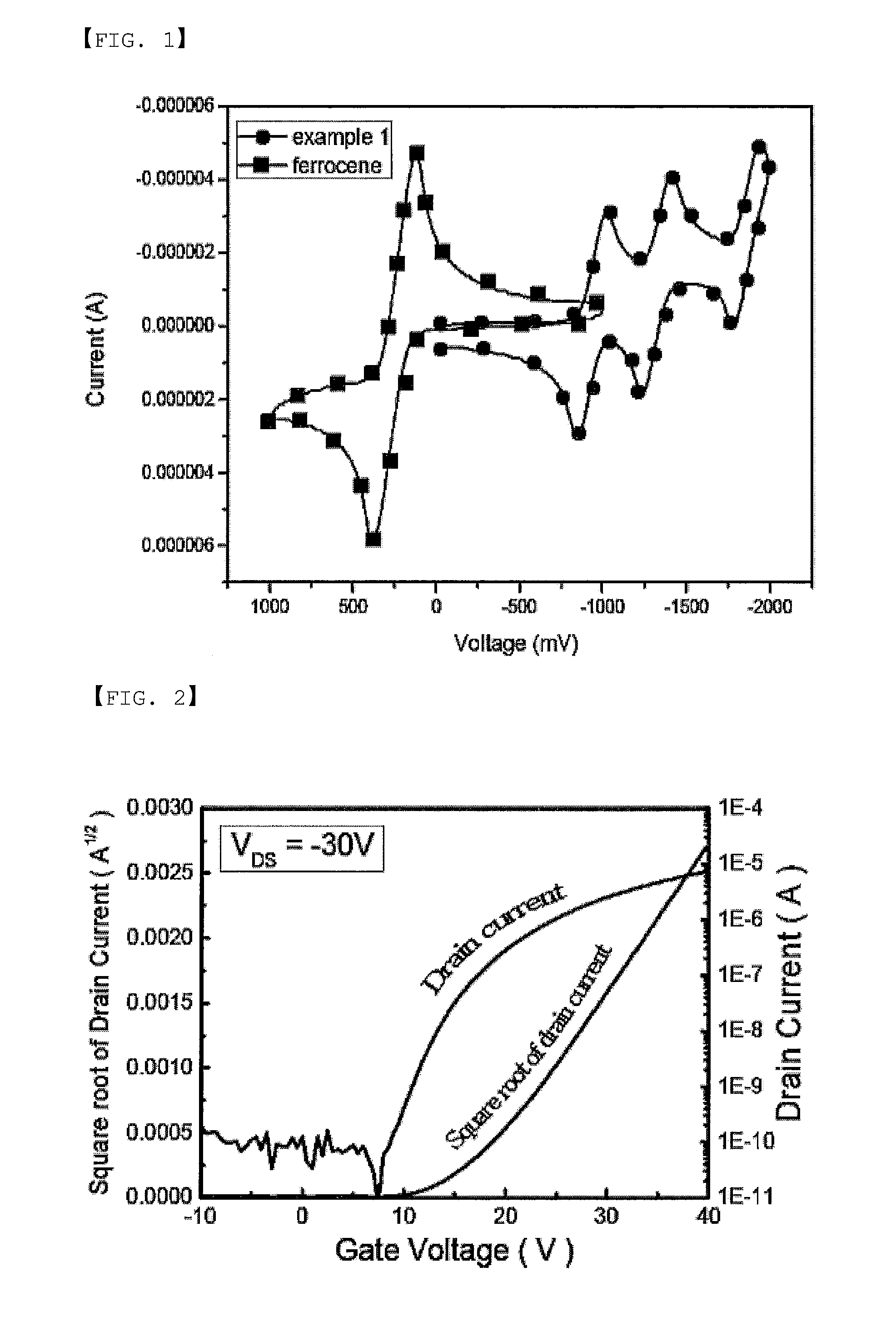Fullerene Derivatives and Organic Electronic Device Comprising the Same
a fullerene derivative and organic electronic device technology, applied in the field of new fullerene derivatives, can solve the problems of low charge mobility of the resistor, stability problem, and inability to be used in devices requiring fast speed, and achieve excellent electron mobility, high open circuit voltage, and so on
- Summary
- Abstract
- Description
- Claims
- Application Information
AI Technical Summary
Benefits of technology
Problems solved by technology
Method used
Image
Examples
preparation example 1
Preparation of Compound 1-1 and Compound 2-1
[0031]
[0032]Benzocyclobutene (0.51 g, 5 mmol) and fullerene C60 (0.3 g, 0.42 mmol) were dissolved in 1,2-dichlorobenzene (50 mL) within a reaction vessel, and then reaction at 190° C. was performed for 24 hours. After completion of the reaction, the solvent was concentrated under reduced pressure, and developed by silica gel column chromatography (40×10 cm) using a mixture solution of benzene and hexane (1:7), thereby obtaining brown solids, mono-adduct (Compound 1-1) (83 mg, 21%) and di-adduct (Compound 2-1) (110 mg, 28%).
[0033]Mono-Adduct (Compound 1-1):
[0034]1H-NMR 300 MHz (CDCl3) δ 7.69-7.67 (m, 2H), 7.58-7.55 (m, 2H), 4.82-4.80 (m, 2H), 4.47-4.42 (m, 2H).
[0035]3C-NMR 500 MHz (CDCl3=77.00 ppm) δ 146.49, 146.27, 145.48, 144.74, 142.60, 142.25, 138.15, 128.02, 65.94, 45.12, 30.92.
[0036]FABMS m / z: 824 (M+H): calcd. (C68H8), 824.
[0037]Di-Adduct (Compound 2-1):
[0038]1H-NMR 300 MHz (CDCl3) δ 7.94-7.28 (m, 8H), 5.08-3.91 (m, 8H).
[0039]13C-NMR...
preparation example 2
Preparation of Compound 1-2 and Compound 2-2
[0041]
Preparation of (4-methyl-1,2-phenylene)dimethanol
[0042]4-Methylphthalic anhydride (5 g, 30.84 mmol) was dissolved in ether (90 mL), and then aluminum lithium hydride (LiAlH4, LAH) (2.9 g, 77.09 mmol) was added thereinto at −78° C. The resulting mixture was stirred for 30 minutes, and then the temperature was gradually raised, followed by reaction at room temperature for 24 hours. After reaction, the resultant material was cooled by an ammonium chloride solution, and the solvent was concentrated under reduced pressure, followed by washing with ethylacetate twice and again washing with distilled water once. The organic layer is separated and then dried over sodium sulfate. Then, the solvent was concentrated under reduced pressure, and developed by silica gel column chromatography (40×10 cm) using a mixture solution of ethylacetate and hexane (2:5), thereby obtaining white solids, (4-methyl-1,2-phenylene)dimethanol (3.73 g, 80%).
[0043]1...
preparation example 3
Preparation of Compound 1-3 and Compound 2-3
[0052]
Preparation of dimethyl 4,5-dimethylcyclohexa-1,4-diene-1,2-dicarboxylate
[0053]Dimethyl acetylendicarboxylate (5 g, 35.18 mmol) was dissolved in benzene (50 mL), and then 2,3-dimethyl-1,3-butadiene (2.72 g, 33.07 mmol) was added thereinto in the presence of nitrogen, followed by stirring under reflux for 24 hours. After the reaction, the solvent was concentrated under reduced pressure, followed by washing with ethylacetate twice and again washing with distilled water once. The organic layer was separated, and then dried over sodium sulfate. Then, the solvent was concentrated under reduced pressure, and developed by silica gel column chromatography (40×10 cm) using a mixture solution of ethylacetate and hexane (1:5), thereby obtaining white solids, 4,5-dimethylcyclohexa-1,4-diene-1,2-dicarboxylate (5.68 g, 72%).
[0054]1H-NMR 300 MHz (CDCl3) δ 3.77 (s, 6H), 2.92 (s, 4H), 1.66 (s, 6H)
Preparation of dimethyl 4,5-Dimethylbenzene-1,2-dicarb...
PUM
| Property | Measurement | Unit |
|---|---|---|
| temperature | aaaaa | aaaaa |
| LUMO energy level | aaaaa | aaaaa |
| LUMO energy level | aaaaa | aaaaa |
Abstract
Description
Claims
Application Information
 Login to View More
Login to View More - R&D
- Intellectual Property
- Life Sciences
- Materials
- Tech Scout
- Unparalleled Data Quality
- Higher Quality Content
- 60% Fewer Hallucinations
Browse by: Latest US Patents, China's latest patents, Technical Efficacy Thesaurus, Application Domain, Technology Topic, Popular Technical Reports.
© 2025 PatSnap. All rights reserved.Legal|Privacy policy|Modern Slavery Act Transparency Statement|Sitemap|About US| Contact US: help@patsnap.com



